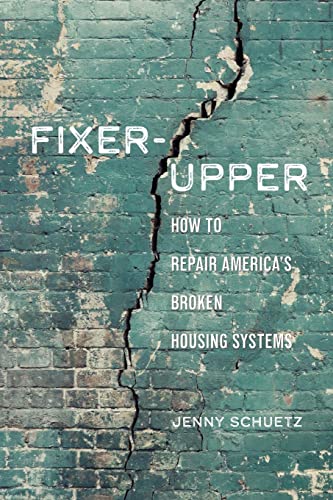You have /5 articles left.
Sign up for a free account or log in.
 Fixer-Upper: How to Repair America’s Broken Housing Systems by Jenny Schuetz
Fixer-Upper: How to Repair America’s Broken Housing Systems by Jenny Schuetz
Published in February 2022
I’ve argued that higher ed is in the middle of an invisible faculty/staff housing crisis.
Invisible not because the people in the middle of not being able to find a place to buy or rent reasonably close to the teaching or staff job they are starting are unaware of the challenges.
Rather, invisible because our higher ed community almost wholly ignores faculty/staff housing as a topic of inquiry and conversation at our conferences, professional groups and industry publications.
Perhaps Jenny Schuetz’s fantastic new book, Fixer-Upper, will provide us the opportunity to talk about academic workforce housing.
As we learn in Fixer-Upper, the roots of the higher ed housing crisis mirror the national story.
With a few notable exceptions (I’m thinking of the NYC schools), universities have mainly approached faculty/staff housing as not their problem. When given thought at all, the thinking is that the private market will provide.
Over the years, a market-based solution for academic workforce housing has proven spectacularly inadequate. The result is that colleges and universities go through spurts of prioritizing and deprioritizing workforce housing. Homes close to campus are purchased to be made available to employees, only to be sold back again into the private market when university leadership turns over.
Academia’s laissez-faire approach to workforce housing sort of, somewhat worked. Until it didn’t. What happened is that the national, state and local policy failures around ensuring an adequate supply of affordable housing have finally caught up to higher education.
University leaders are realizing, perhaps too late, that recruiting talented faculty and staff to come to their institutions is made dramatically more complicated if that recruit cannot find an affordable place to live.
Where Fixer-Upper is particularly helpful is in unpacking the roots of our national housing crisis. Schuetz systematically explains how housing does not adhere to the normal mechanisms of supply and demand. Housing supply, and therefore housing prices, are the products of a dizzyingly complex array of local decisions, zoning regulations and incentives.
Builders are seldom incentivized to develop housing that is affordable for middle-income workers. The challenges of land acquisition, permitting and compliance with local building codes mean that it is almost always more advantageous for builders to develop housing for the wealthy.
In the U.S., local residents strongly influence what can be built and where. As the wealth of most households is tied up in their homes, all the incentives run toward ensuring that supply stays low and prices stay high. Political efforts to rein in local property taxes, such as California’s 1978 Proposition 13, have disincentivized homeowners from moving, therefore artificially tamping down supply.
Unlike wealthy countries that have invested in extensive public housing programs, the U.S. has done little to ensure that its citizens have access to decent, affordable housing. In the U.S., housing is not an entitlement. The supply of public housing units has steadily eroded, while the funding for Section 8 housing vouchers significantly lags demand.
Nationally, the result is a growing number of families who are cost-burdened, paying more than 30 percent of their income toward housing. In many localities, the fastest-growing proportion of renters are those who are severely cost-burdened, as defined by devoting 50 percent or more of household income to rental costs.
The upshot of the U.S. housing story for colleges and universities is that institutional leaders will need to put workforce housing much higher on their list of concerns. Without sustained investment, the imbalance between the academic workforce’s demand for housing and available supply will grow larger.
Housing is, of course, a tricky proposition for universities to navigate. Buying up local housing for faculty and staff decreases the housing supply for local residents and can drive up prices. Building new academic workforce housing is almost always a lower priority than building new student residence halls and apartments.
It is also tempting to think that this new era of remote, flexible and hybrid work will solve our academic workforce housing crisis. If faculty and staff can live anywhere, why invest in growing the housing supply close to campus?
And, of course, university budgets are severely constrained—and grow more so in each passing year. Academic workforce housing may be an issue for some faculty and staff. Still, it does not seem to be rising to the level of existential crisis that so many other higher ed challenges present.
At the very least, we should have broader, more inclusive and more systematic campus discussions about faculty and staff housing.
Maybe reading Fixer-Upper will catalyze some of those campus conversations.
What are you reading?








